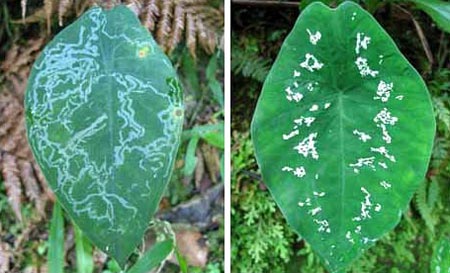The fake tree is sick to ward off the enemy
Scientists have found a plant capable of pretending to be ill to fool moths in Ecuador.

The leaves on the left have many white streaks caused by worms, while the white spots on the right leaf are created by trees to deceive moths.Photo: BBC.
Leaf spot is a common disease in plants and arises due to many causes. When plants get sick, their leaves often have colorful spots on the surface. One of the common causes is that the cells in the leaves lose chlorophyll so they no longer have the ability to photosynthesize the leaves to have white spots.
In theory, plants with leaf spots often grow slowly due to reduced organic matter production. However, some botanists from the University of Bayreuth (Germany) claim that this is not entirely true after they discovered that some species pretend to be ill to deceive leaf-eating animals.
During a low-vegetation study in a southern Ecuadorian forest, the Bayreuth University team found that moth larvae attack the Caladium steudneriifolium plant much more than other species. It is worth noting that the more spotted the leaves are, the less the number of butterfly larvae in the tree will be.
Moths lay eggs on leaves. After the larvae turn into worms they will eat the chlorophyll of the leaves and leave the white cuticle behind. The team found that many Caladium steudneriifolium plants have white spots on their leaves, although they have never been attacked by worms.
'White spots on healthy leaves can be a way to fool moths, making them not want to lay eggs on leaves,' said Sigrid Liede-Schumann, the team leader.
To verify this hypothesis, the team applied a white paint to hundreds of healthy leaves in an area. After three months, they counted the number of deep-leafed leaves eaten in three groups: completely green, white spots and painted. 'The rate of leaves with leaves and leaves with deep attack is much lower than green leaves completely. That surprised us, ' Liede-Schumann said.
Specifically, worms eat 8% green leaves, but only attack 1.6% mottled leaves and 0.4% leaves are painted. The team believed that the tree was fake by creating white-speckled leaves. When butterflies land on the leaves and see fake spots, they will think that the leaves have been eaten beforehand so they will not lay eggs on them.
'The existence of both green leaves and leaf spots on the plants suggests that they all have a role in the development of the plant. The fake spots on the leaves make the plants' photosynthesis decrease, but in return the trees will not lose much leaves by the worm. Thus, the phenomenon of leaf spot is maintained in many plants because it is an evolutionary beneficial characteristic , 'Liede-Schumann said.
- The amazing 'eavesdrop' system of trees
- The oldest tree in England has changed sex after 3,000 years
- Many people carefree planting Christmas trees indoors without knowing the consequences
- Ancient trees have unique and strange shapes all over the world
- The mock serpent died to deceive the stray cat
- Mysterious fir tree regenerates itself from the dead
- Thinking you sick will make you sick
- How to recognize fake beef with just one sheet of paper, everyone can do it
- 5 ways to identify standard fake plastic rice without correction
- He deciphered the ash tree sequence
- Story about 'devil tree': Witness the massacre of 1 family and many other deaths
- Instructions on how to distinguish the most real and fake cosmetics
 Why do potatoes have eyes?
Why do potatoes have eyes? 'Tragedy' the world's largest carnivorous life: Death becomes ... public toilet
'Tragedy' the world's largest carnivorous life: Death becomes ... public toilet Tomatoes were once considered 'poisonous' for 200 years
Tomatoes were once considered 'poisonous' for 200 years Detecting microscopic parasites on human face
Detecting microscopic parasites on human face